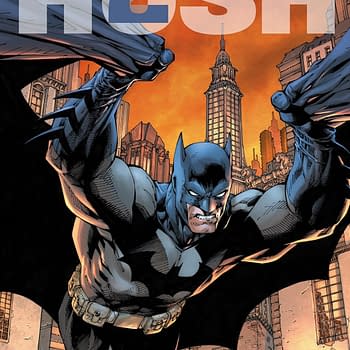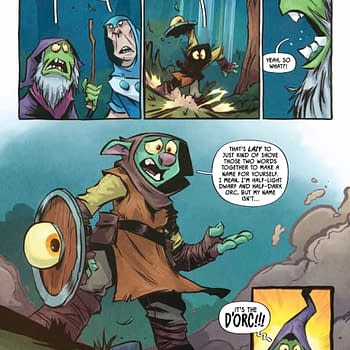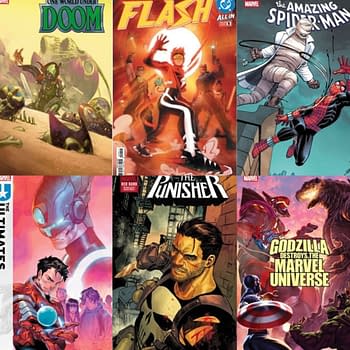Posted in: Comics, Review | Tagged: black mask, Dee Cunniffe, Eric Zawadzki, HRL, Lonnie Nadler, The Dregs, Zac Thompson
The Dregs #4 Review: Let's Lynch The Landlord

Here's the thing about the noir genre: regardless of what medium it arrives in, it's incredibly difficult to pull off in the modern era (that goes for basically every "modern era" since the time of the original noirs ended about 50-60 years ago).
If you look at noir in cinema, for every Chinatown or Brick (or hell, even Blade Runner) there's about 100 more totally forgotten and hideously remembered "neo-noir" attempts that never landed. Consider Things To Do In Denver When You're Dead or 2 Days In The Valley, to name two films you haven't heard of — though there is a dynamite Warren Zevon song Denver is named after, and 2 Days is kind of watchable for a deranged and psychotic James Spader hitman performance.
In comics it's the same way; for every Criminal or 100 Bullets, there are dozens of attempts at modern noir stories. A fair bit of them are from Vertigo, for some reason — it's one of those comic story tropes that they seemed to recycle every few years with new creative teams, along with stories about New Orleans, British punks, vampires or mildly heavy handed political satire. That's what makes The Dregs #4 (and the entire run of the story) so remarkable; it did what's basically next to impossible to do in comics — make a modern, neo-noir that actually works in form and function without being goofy or obvious — and made it even more tricky by working in a beautifully progressive, radical subtext to the piece.
If you haven't been reading The Dregs since its first issue, then I am baffled as to why you're reading a review of number four. But then again, I'm not the right person to ask anyway, because I don't understand why people read reviews at all in the first place. But you do and so here we are, welcome, to both of us. But! If you haven't been reading The Dregs since its first issue, then, honestly what's your problem?
This is a four-issue series. We're not talking about Fables or The Walking Dead here. I bet you found time to pick up that new Zelda game everyone's talking about. You are unbelievable, you know that? If you haven't been reading The Dregs since its debut, then let me quickly catch you up on what's happened to get us to this ending, that is like the words and pictures equivalent of a Pixies song: LOUD quiet, LOUD quiet.

The story so far: This story takes place in Canada, but isn't a hoot and a half, so fans of Trailer Park Boys and Mike Meyers, just calm down for a minute. Yes, it takes place in Canada, but nobody says "aboot" and people aren't super polite and there isn't a hunky prime minister hunking around being hunky, constantly being celebrated for being so cute and so not the guy he replaced. Remember America? We kinda went through a thing like that back in '08; there was a kind of hunky President, who we celebrated constantly because he wasn't the guy he replaced? And that worked out perfectly.
The story takes place in Vancouver, B.C. in a section of town known as "The Dregs", which is the last bit of Vancouver's downtown area that hasn't been totally gentrified yet — though wheels are spinning to try to make that happen. Our protagonist Mr. Arnold/Philip Marlowe lives a life on the street while addicted to the fictional drug "listo", reading pulp novels, living rough but connected to a community of the poorest members of society.
These people occupy a bewildering space in society where they are constantly overlooked, while at the same time constantly being made the scapegoat by and for the rest of society. How can people who are forgotten on a daily basis still take up so much of our minds? They're there when we need to shift blame, but vanish when it comes time to think about the repercussions of "urban development" (or "urban renewal" or any other sinister euphemism you like).

Mr. Arnold's best friend Manny disappears at the outset to the story, killed and butchered and fed to the upper-middle class in a trendy downtown eatery. Arnold sets out to find Manny and along the way encounters low level scummy dealers, creepy real estate moguls, earnest officers, femme fatales, murderers, junkies, and a large-but-dwindling community of street people. Arnold isn't trying to set the world to rights, he just wants answers about Manny. He'd also like to not get killed, cooked, and eaten in the process.
In this final installment, we see things come to a head between Arnold and the slimy real estate mogul who's been orchestrating the tearing down of the old city and the monetization (and cannibalization) of the bits left in its wake.
He tears around the city, giving out last cries for justice or attention or reason as he climbs, falls, walks, and runs through a shifting, animated version of The City (which has become not only an entity in and of itself by this point, but also is congruous with every city, everywhere in the developed western world). He runs into definite hallucinations and possible ones, and ends up contemplating his next move from across the bridge, staring back at the city, recognizing the choices he has ended up with. It's a very Trainspotting kind of ending in some ways, though its arrival seems a little more out of the blue than in the Scottish Skag movie of the '90s.

We haven't really seen Arnold express a desire to end his addiction to listo and to escape his life on the street. We've only really seen a reoccurring motif of life on the streets being something that no one escapes from. We are given only the slimmest of views of Arnold's life pre-Dregs and beyond his reading and fantasy life as a Private Eye, we don't really know what Arnold's future, post-listo could be. It seems like he needs to leave the city in order to survive, but his entire life is there and everyone he knows is being rounded up, killed, cooked, and served to the next person waiting their turn to go under the steak knife.

I think one way of approaching the end of the book, as well as everything that's occurred leading up to it, is that none of the cannibal horror aspects of this book are actually "real" — instead of a cannibal horror story book with a radical subtext at the outset, it's actually a neo-noir, cannibal horror story book with a radical subtext. Like, an American Psycho sort of real, but Canadian. If we view the story as the listo-fried paranoia of a street addict who is trying to come to terms with the loss of his best friend, the gentrification of everything he's known, and a crushing addiction to a deadly and hallucinogenic substance, then the ending makes total sense. Well, at least more sense.
At the end, Arnold has his copy of The Long Goodbye in one hand and another hit of listo in the other, and we're supposed to take away (I believe?) that these are representative of his two options at this point, escape or death. I can see how listo represents "death", but I'm not sure what The Long Goodbye represents other than the subject that kept him fascinated and thinking while enduring a harder than average life on the concrete. This also ties in with the moving and beautiful photo segment in the back, Off Hours by Thanh Nguyen which focuses on how people living on the streets of Vancouver cope with boredom.

What is important about the ending however is not if it totally nails whatever sort of neo-noir trope checklist you may be harboring or whether or not the baddies get caught and the hero gets celebrated. What is important is how much the ending reflects the overall tone and feel of the book. This was never going to be a A finds B and settles C with D for E kind of tale. Rather the ending of the book sort of wraps up nicely (hey! just like endings are supposed to do!) the major themes of the book; or rather it at least amplifies them until they explode and then brings the audience to a breathing point by the water to reflect.
The Dregs #4 takes us with Arnold as he confronts the various persons and establishments he's been ramming his head into for the past three issues. Everything is brought to a head and Arnold discovers the old adage about trying to beat city hall is depressingly accurate. The writing is smart and timely, as you can feel the emotions and urgency from the writers coming out of Arnold's mouth; making the withering rebuttals from authority even more devastating. As in, it would be great if there was a demon you could punch to stop the gutting of cities and the throwing away of human lives for dollar signs, but the "hard truths" aren't fantastical — they are boring and ugly.
I'd be a terrible reviewer and possibly even just a pretty bad human being if I failed to mention the complete and total success the art team brought to the book. They are able to conjure up the surreality dreamscape of the Vancouver of Arnold's fevered mind as well as never failing to show you the guts and blood and more real than you may have liked reality of the corporeal world of The Dregs. Rainy nights are haunting and somber, private eye dreams are stark and mad, and, well, a quote from Aesop Rock I think not only nails the tonality of the art as well as the book in general: "This little piggy went to the market with a target and will subsequently know the armor piercing forks of farmers."

The Dregs #4 is a smart, wicked, dark, hopeful, bloody, furious, angry, hurt howl. These days a lot of people are howling for a lot of reasons. Some of them howl at their loss of privilege. Some of them howl at their loss of freedom. The Dregs is a howl for the latter. Don't let it get lost in the din.













